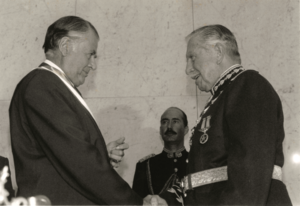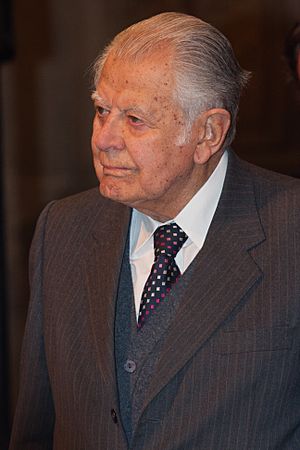Patricio Aylwin facts for kids
Quick facts for kids
Patricio Aylwin
|
|
|---|---|

Official portrait, 1990
|
|
| 30th President of Chile | |
| In office 11 March 1990 – 11 March 1994 |
|
| Preceded by | Augusto Pinochet Ugarte |
| Succeeded by | Eduardo Frei Ruiz-Tagle |
| President of the Senate of Chile | |
| In office 12 January 1971 – 22 May 1972 |
|
| Preceded by | Tomás Pablo Elorza |
| Succeeded by | José Ignacio Palma |
| Senator of the Republic of Chile for the Sixth Provincial Grouping (Curicó, Talca, Linares and Maule) |
|
| In office 15 May 1965 – 11 September 1973 |
|
| Personal details | |
| Born |
Patricio Aylwin Azócar
26 November 1918 Viña del Mar, Chile |
| Died | 19 April 2016 (aged 97) Santiago, Chile |
| Resting place | Cementerio General de Santiago, Santiago |
| Political party | Christian Democratic Party |
| Spouse | |
| Children | 5 |
| Alma mater | University of Chile |
| Occupation | Lawyer |
| Signature | |
Patricio Aylwin Azócar (born November 26, 1918 – died April 19, 2016) was an important Chilean politician. He was a lawyer, writer, and university professor. He also served as a senator.
Patricio Aylwin became the first president of Chile after the country was led by Augusto Pinochet. His election in 1990 marked the return of democracy to Chile. After becoming president, Aylwin strongly supported a group called the National Commission for Truth and Reconciliation. This group worked to find out the truth about the serious human rights problems that happened during the time of the dictatorship.
Contents
Early Life and Education
Patricio Aylwin was born in Viña del Mar, Chile. He was the oldest of five children. His parents were Miguel Aylwin and Laura Azócar.
He was a very good student. He studied law at the University of Chile. In 1943, he became a lawyer with top honors. Later, he taught law at the University of Chile and the Pontifical Catholic University of Chile. He also taught civics and economics at the National Institute. His brother, Andrés Aylwin, also became a politician.
In 1948, Patricio Aylwin married Leonor Oyarzún Ivanovic. They had five children and 14 grandchildren. One of his daughters, Mariana, worked as a minister in later governments. His granddaughter, Paz Bascuñán, became a well-known actress.
Political Journey

Patricio Aylwin started his political career in 1945. He joined a political group called the Falange Nacional. He later became the leader of this group. This group then became the Christian Democratic Party of Chile. Aylwin was elected president of this new party seven times between 1958 and 1989.
In 1965, he was elected to the National Congress as a Senator. By 1971, he became the president of the Senate. During the government of Salvador Allende, Aylwin was also the leader of his party. He led the groups that were against Allende's government. He tried to find a peaceful way to solve the country's political problems.
Aylwin continued to lead the Christian Democrats until 1976. After the death of the party's main leader, Eduardo Frei Montalva, in 1982, Aylwin guided his party during the military government. He helped create a group to bring together democratic parts of the country against the dictatorship. In 1979, he spoke out against a vote that approved a new constitution.
In 1982, Aylwin became the vice president of the Christian Democrats. He was one of the first to say that the Constitution should be accepted. This was to help bring back democracy. The groups against the dictatorship followed the rules set by the government. They took part in a special vote in 1988.
On October 5, 1988, the Chilean national plebiscite was held. A "Yes" vote would have allowed Pinochet to stay president for eight more years. But the "No" campaign won! This was partly thanks to a great media campaign, which you can see in the 2012 movie No. Patricio Aylwin was a key leader in the movement that defeated General Pinochet. After this vote, he helped with talks that led to 54 changes in the constitution. This made a peaceful change from 16 years of dictatorship to democracy possible.
Presidency
| The Aylwin Cabinet | |||
|---|---|---|---|
| Office | Name | Party | Term |
| President | Patricio Aylwin | DC | 11 March 1990–11 March 1994 |
| Interior | Enrique Krauss | PS | 11 March 1990–11 March 1994 |
| Foreign Affairs | Enrique Silva Cimma | PR | 11 March 1990–11 March 1994 |
| Defense | Patricio Rojas | DC | 11 March 1990–11 March 1994 |
| Finance | Alejandro Foxley | DC | 11 March 1990–11 March 1994 |
| Gen. Sec. of the Presidency |
Edgardo Boeninger | DC | 11 March 1990–11 March 1994 |
| Gen. Sec. of Government |
Enrique Correa | PS | 11 March 1990–11 March 1994 |
| Economy | Carlos Ominami | PS | 11 March 1990–28 September 1992 |
| Jorge Marshall | PPD | 28 September 1992–16 December 1993 | |
| Jaime Tohá | PS | 16 December 1993–11 March 1994 | |
| Social Development |
Sergio Molina Silva | DC | 11 March 1990–11 March 1994 |
| Education | Ricardo Lagos | PPD | 11 March 1990–28 September 1992 |
| Jorge Arrate | PS | 20 September 1992–11 March 1994 | |
| Justice | Francisco Cumplido | DC | 11 March 1990–11 March 1994 |
| Labor | René Cortázar | DC | 11 March 1990–11 March 1994 |
| Public Works | Carlos Hurtado Ruíz-Tagle | Ind. | 11 March 1990–11 March 1994 |
| Health | Jorge Jiménez | DC | 11 March 1990–30 October 1992 |
| Julio Montt | DC | 30 October 1992–11 March 1994 | |
| Housing & Urbanism |
Alberto Etchegaray Aubry | Ind. | 11 March 1990–11 March 1994 |
| Agriculture | Juan Agustín Figueroa | PR | 11 March 1990–11 March 1994 |
| Mining | Juan Hamilton Depassier | DC | 11 March 1990–28 September 1992 |
| Alejandro Hales | DC | 28 September 1992–11 March 1994 | |
| Transport & Telecom |
Germán Correa | PS | 11 March 1990–28 September 1992 |
| Germán Molina Valdivieso | PPD | 28 September 1992–11 March 1994 | |
| National Assets | Luis Alvarado Constenla | PPD | 11 March 1990–11 March 1994 |
| Environment | Jaime Tohá | PS | 11 March 1990–11 March 1994 |
| Women | Soledad Alvear | DC | 11 March 1990–11 March 1994 |
Patricio Aylwin was elected president of Chile on December 14, 1989.
Domestic Policies and Challenges
Even though Chile became a democracy again, the military, led by Pinochet, still had a lot of power. The Constitution also gave Pinochet and his commanders continued influence. This made it hard for Aylwin's government to achieve all its goals. For example, they wanted to change the Constitutional Court and reduce Pinochet's political power.
However, Aylwin's government did start direct local elections. The first ones were held in June 1992. Despite the limits, his government managed to change power relations in the state and society over four years. Aylwin tried to bring justice to those in the military who had committed abuses.
Economic and Social Progress
The Aylwin government worked hard to reduce poverty and inequality in Chile. In 1990, they introduced a tax reform. This increased tax money by about 15%. This extra money allowed the government to spend more on social programs. Spending on these programs went from 9.9% to 11.7% of the country's total economic output.
By the end of Aylwin's time as president, a lot of money was being spent on social programs. These included better public health programs and training programs for young Chileans. There was also a big effort to build public housing.
A new fund was created to help poorer communities. Spending on social services, especially health and education, increased by about one-third between 1989 and 1993. A new labor law was also passed in 1990. This law gave more rights to trade unions and improved pay for workers who lost their jobs. The minimum wage was increased, along with family allowances and pensions.
Between 1990 and 1993, real wages grew by 4.6%. The number of people without jobs dropped from 7.8% to 6.5%. Spending on education went up by 40%, and health spending increased by 54%. The income of poor Chileans grew by 20% after inflation. The minimum wage in 1993 was 36% higher than in 1990. A program to clear slums was also started. Over 100,000 new homes were built during Aylwin's government. This was much more than the 40,000 homes built each year under the previous government.
Under Aylwin's leadership, fewer Chileans lived in poverty. A United Nations report estimated that the percentage of people living in poverty fell from about 40% in 1989 to about 33% by 1993.
End of Presidency
Patricio Aylwin's term ended in 1994. He was followed by Eduardo Frei Ruiz-Tagle, who was also from the Christian Democrat party. Eduardo Frei Ruiz-Tagle was the son of the former president, Eduardo Frei Montalva.
After the Presidency
After his presidency, Aylwin led the Corporation for Democracy and Justice. This was a non-profit group he started. Its goal was to find ways to end poverty and make politics more ethical. In 1998, he received the J. William Fulbright Prize for International Understanding.
Aylwin received special honorary degrees from many universities around the world. These included universities in Australia, Canada, France, Japan, and the United States. In 1997, the Council of Europe gave him the North-South Prize. He shared this award with Mary Robinson, who was the former president of Ireland. They received it for their work in promoting human rights, democracy, and cooperation between Europe and Latin America.
Death
On December 18, 2015, Aylwin was taken to the hospital in Santiago. He had a head injury from a fall at home. He passed away on April 19, 2016, at the age of 97. His death was due to natural causes from breathing problems.
His state funeral was held on April 22, 2016. He was buried at the Cementerio General de Santiago in Santiago.
Awards and Honors
International Honors
 Malaysia:
Malaysia:
 Portugal:
Portugal:
 Spain:
Spain:
 Collar of the Order of Charles III (1991)
Collar of the Order of Charles III (1991) Knight of the Collar of the Order of Isabella the Catholic (1990)
Knight of the Collar of the Order of Isabella the Catholic (1990)
Other Awards
- Council of Europe: North–South Prize (1997)
- Fulbright Association: William Fulbright Prize for International Understanding (1988)
Images for kids
See also
 In Spanish: Patricio Aylwin para niños
In Spanish: Patricio Aylwin para niños







